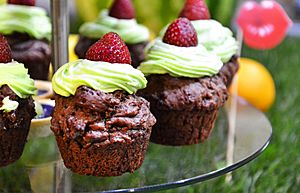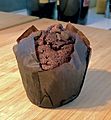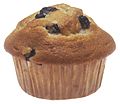Muffin facts for kids
A muffin is a small, baked food that's a bit like bread or cake. Muffins often have a round bottom and a rounded top. They are usually sweet, but some kinds, like cornbread muffins, are savory.
The word "muffin" can also mean a different type of baked food. This is the smaller, flat, disk-shaped English muffin. Outside of Britain, people usually call these "English muffins." In Britain, "muffin" can mean either type. Muffins can have extra ingredients for flavor, like blueberries or chocolate chips. People often eat muffins for breakfast or with tea.
Contents
Quick Bread Muffins: A Sweet Treat
 |
|
| Type | Quick bread |
|---|---|
| Course | Traditionally breakfast |
| Place of origin | United States |
| Main ingredients | Flour, leavening, vegetable oil, sugar |
Quick bread muffins started in the United States in the mid-1800s. In Britain, they are sometimes called "American muffins." They became popular there later, especially with the rise of coffee shops.
These muffins are similar to cupcakes in size and how they are cooked. The main difference is that cupcakes are usually sweet desserts with frosting. Muffins can be sweet, like blueberry or chocolate chip, or savory, like cheese muffins.
People often eat them for breakfast with coffee or tea. You can buy fresh muffins at bakeries, donut shops, and coffeehouses. Many grocery stores also sell muffins made in factories.
How Quick Bread Muffins Are Made
Quick bread muffins are made with flour and a special ingredient called bicarbonate of soda. This ingredient helps them rise and become fluffy.
Other ingredients like butter, eggs, and flavorings are added. These can be fruits like blueberries or bananas, or savory items like cheese. The mixture is poured into a special muffin tray or paper cups. Then, they are baked in an oven until they are golden and risen.
Flatbread Muffins: The English Muffin
 |
|
| Alternative names | English muffin |
|---|---|
| Type | Leavened bread |
| Course | Traditionally breakfast |
| Place of origin | United Kingdom |
| Main ingredients | Flour, yeast |
Flatbread muffins are known as "English muffins" in the United States. They were first written about in the early 1700s, but they are likely much older. The word "muffin" might come from the German word mouffin.
This type of muffin is flat and disk-shaped. It is usually not sweet. English muffins are popular in Commonwealth countries and the United States. People often toast them for breakfast. They can be eaten with butter, jam, or honey. Savory toppings like sausage, egg, or cheese are also popular.
English muffins are made with yeast, which helps the dough rise. They are usually about 4 inches (10 cm) round and 1.5 inches (4 cm) tall. Instead of being baked in an oven, they are cooked on a flat griddle on the stove. They are flipped from side to side, which gives them their flat shape.
English muffins were brought back to the American market in 1880. An English-American baker named Samuel Beth Thomas called them "English muffins." His company, Thomas', still makes them today.
Where the Name "Muffin" Comes From
The word "muffin" first appeared in print in 1703. It was spelled moofin. Its exact origin is not certain. It might come from the Low German word Muffen, which means small cakes. It could also be linked to the Old French word moufflet, meaning soft bread.
How English Muffins Are Made
Here's how a flatbread muffin, or English muffin, is typically made:
Images for kids
See also
 In Spanish: Muffin para niños
In Spanish: Muffin para niños
















